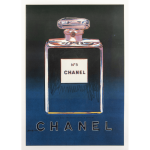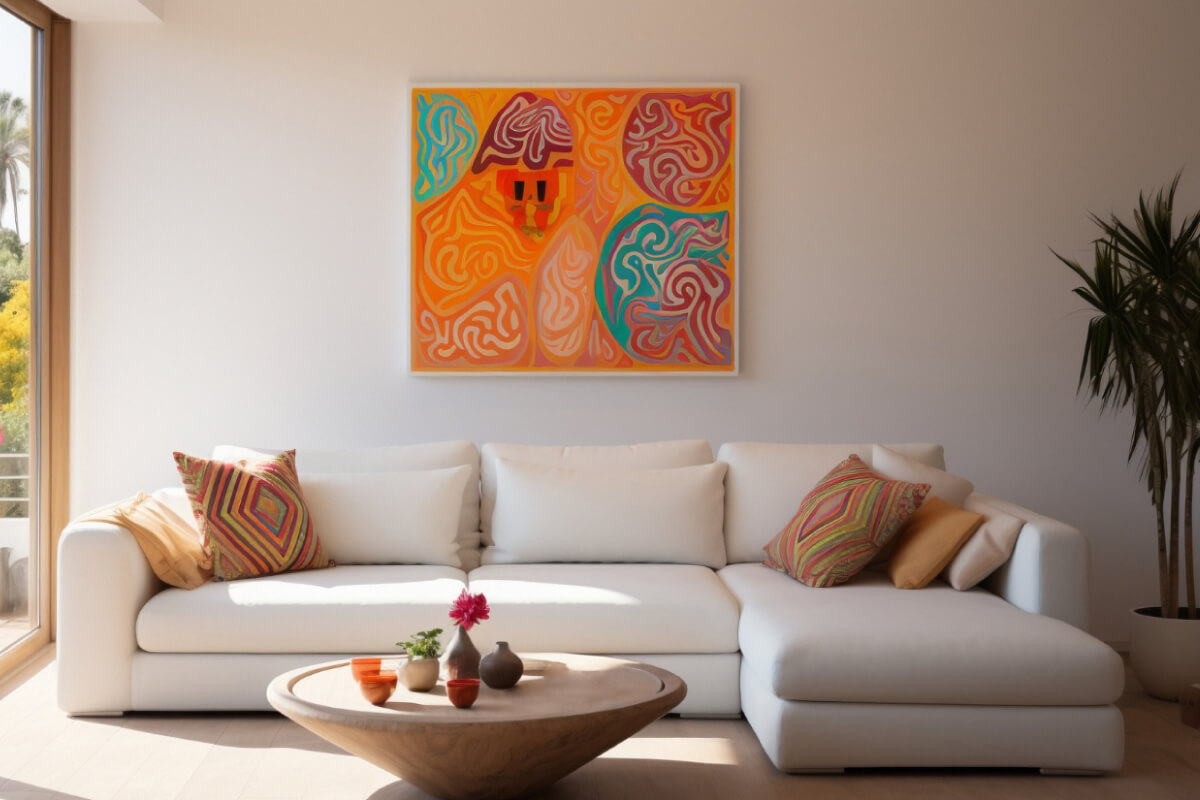Artwork for Sale: In a world where personal expression and the creation of welcoming environments have become imperatives, works of art emerge as key pieces in shaping the aesthetics of interior design. They are not merely paintings on the wall; they are statements of identity, inspiration, and beauty that transform houses into homes.
This article explores the harmony between works of art and interior design, highlighting the benefits that go beyond mere decoration. By bringing individuality into the environment and creating a more pleasant atmosphere, works of art reveal themselves as catalysts in the quest for a space that is truly your own.
Let’s delve into the various styles of artwork that can reflect your interior design aesthetic. Throughout this article, we will immerse ourselves in six distinct styles, each with its personality and charm. From modern and minimalist pieces to more vibrant and daring artistic expressions, there is artwork for every taste and setting. Prepare for a visual journey that will not only adorn your walls but also provide a unique and personalized experience in every space of your home. After all, art is not just seen; it is lived and felt. Let’s discover together which of these styles resonates most deeply with your essence and transforms your space into a masterpiece of personal expression.
From the Golden Age to Contemporary Vanguard: A Journey through Artistic Styles that Transform Your Space
By diving into each of the styles we’ll mention, you’ll have the opportunity to discover which one best suits your interior design aesthetic, transforming your home into an authentic expression of your personality and artistic taste.
Art Deco: A Tribute to Classic Elegance
Art Deco, an artistic style that flourished in the 1920s and 1930s, represents an era of elegance and sophistication that transcends mere decoration. Characterized by distinctive geometric lines, luxurious materials, and ornate details, Art Deco is not just a visual style but a cultural manifestation that extends across various forms of artistic expression.
When exploring artworks within the Art Deco style, such as those available in searches for “artwork for sale Art Deco,” it becomes evident how these pieces stand out as true tributes to classical elegance. Paintings, sculptures, and prints capture the essence of this glamorous era, transporting viewers to a time when refined aesthetics were an expression of modernity and prosperity.
To incorporate Art Deco into your interior design aesthetic, it is possible to explore the richness of this style by combining classical elements with influences from non-Western cultures. The Egyptian, Mayan, Chinese, and Japanese aesthetics, for example, play a significant role in creating an authentic Art Deco atmosphere.
-
Art Nouveau: Nature as Inspiration
Inspired by nature, Art Nouveau flourished in the late 19th and early 20th centuries until the outbreak of World War I. Its sinuous and organic forms translate into artworks that capture the fluid beauty of flora and fauna. When exploring Art Nouveau, discover how pieces within this style can bring a sense of natural harmony to your space. Delve into the distinctive characteristics of Art Nouveau and learn how to seamlessly integrate them into your interior design by combining geometric shapes from Cubism and Viennese Secession, vibrant colours from Fauvism and the Ballets Russes, and craftsmanship from the furniture of the Louis XVI and Louis Philippe I periods. This fusion of elements creates an environment that echoes the organic elegance of Art Nouveau while incorporating varied influences for a unique and immersive aesthetic experience.
-
Retro: A Stylish Journey Through Time
Revitalize the charm of bygone eras through retro-style artworks. Immerse yourself in the vibrant energy of the 1960s or the timeless elegance of the 1950s; retro pieces provide a unique connection to the past. When exploring “Artwork for Sale Retro,” you’ll discover illustrations, photographs, and paintings that capture the nostalgia of specific periods. Learn how to incorporate retro elements to enhance without compromising the modernity of your space, creating a charming fusion of the past and present. Allow these artworks to transcend mere decoration, transforming your environment into a visual testament to the rich stylistic heritage of decades gone by while still maintaining the contemporaneity and vitality of your current space.
-
From Icons to Ideologies: The Everlasting Impact of Pop Art
 Pop Art, was an artistic movement that emerged in the 1950s and 1960s but continued to influence art in the 1970s and 1980s, characterized by the use of images and objects from popular culture, such as comic strips, soup cans, traffic signs, and hamburgers, as themes or elements of the artwork. Pop Art had a critical and ironic intention, questioning the values of consumer society and mass media. Some of the most famous Pop Art artists included Andy Warhol, Roy Lichtenstein, and Jasper Johns. In the 1970s and 1980s, Pop Art gave rise to other movements and styles, such as Photorealism, which reproduced photographs with great precision; Neo-Expressionism, which revived traditional painting with bold colours and expressive brushstrokes; and the Pictures Generation, which used existing photographs to reveal the ideologies that produced them. Visit GL-Arte, and have the exclusive opportunity to acquire a curated selection of Pop Art masterpieces.
Pop Art, was an artistic movement that emerged in the 1950s and 1960s but continued to influence art in the 1970s and 1980s, characterized by the use of images and objects from popular culture, such as comic strips, soup cans, traffic signs, and hamburgers, as themes or elements of the artwork. Pop Art had a critical and ironic intention, questioning the values of consumer society and mass media. Some of the most famous Pop Art artists included Andy Warhol, Roy Lichtenstein, and Jasper Johns. In the 1970s and 1980s, Pop Art gave rise to other movements and styles, such as Photorealism, which reproduced photographs with great precision; Neo-Expressionism, which revived traditional painting with bold colours and expressive brushstrokes; and the Pictures Generation, which used existing photographs to reveal the ideologies that produced them. Visit GL-Arte, and have the exclusive opportunity to acquire a curated selection of Pop Art masterpieces.
-
Street Art: From Thierry Noir’s Berlin Wall to Stik’s Social Commentary in Street Art

Street Art is a form of urban art that utilizes the streets as both canvas and means of expression. Emerging in the 1960s and 1970s, Street Art gained prominence in the 1980s, with artists like Thierry Noir making a significant impact. Noir painted the Berlin Wall with colourful and ironic characters, challenging the communist regime and the city’s division. Thierry Noir is recognized as the first artist to systematically paint the Berlin Wall, inspiring a new generation of street artists. Among them is Stik, a London-born artist who uses his stick-figure motif to comment on social issues such as the destruction of social housing and homelessness.
-
Contemporary
In the contemporary universe, art becomes a reflection of the diversity, experimentation, and interdisciplinarity of modern society. When exploring works by contemporary artists, uncover a profusion of styles, media, and expressions. Contemporary art transcends borders, adding a layer of depth and reflection to the environment. Learn to select pieces that resonate with your vision of interior design, allowing artistic expression to harmoniously dialogue with the innovation present in your space. This fusion of contemporary elements creates a dynamic environment where art not only decorates but also challenges and inspires, reflecting the effervescent essence of the modern era.
-
Minimalist: Less is More, in Colors and Shapes
For enthusiasts of simplicity and functionality, the minimalist style offers a stripped-down and elegant approach. When exploring “artworks Minimalist,” you’ll find pieces that celebrate beauty in simplicity, using strong and contrasting colours, organic and irregular forms, as well as various textures and materials. Discover how minimalism can transform your space into a serene retreat, focusing on abstraction, geometry, and repetition.
-
Industrial: The Raw Charm of Urbanity
Inspired by urban elements such as graffiti, concrete, metal, and glass, the industrial style brings the robustness of raw materials into the realm of art. Search for “artworks for sale Industrial” to find pieces that incorporate metal, concrete, and rough textures. Explore how to integrate industrial style into your interior design, creating contrasts, harmonies, focal points, and sensations of comfort and well-being.
Artwork for Sale: Conclusion
On a journey through the artistic styles that permeate the decades and shape interior design, we become immersed in the richness and diversity that art brings to our environment. From the classic refinement of Art Deco to the enchanting organicity of Art Nouveau, from nostalgic time travel with Retro to contemporary innovation, from serene minimalism to industrial robustness, each style is a unique expression of creativity and personality.
In this article, we explore not only visual aesthetics but also the essence of each style. Art Deco, born in the 1920s and 1930s, emerges as a tribute to elegance, combining classical elements with influences from non-Western cultures. Art Nouveau, inspired by nature, invites us to integrate its sinuous forms and vibrant colours, while Retro allows us to relive the timeless charm of past decades.
The choice of artwork goes beyond aesthetics; it is a personal statement, a way to tell your story and reflect your identity. By incorporating these styles into your interior design, you create a space that is not only visually appealing but also emotionally significant.
Let yourself be carried away by art that is not just seen but lived and felt. Find pieces that not only adorn your walls but transform your home into an authentic sanctuary of your personality.
Beauty lies in diversity. Embark on this artistic journey, and may each artwork be a step in creating the home of your dreams. Visit our gallery and transform your space into a masterpiece that tells the unique story that is your life.

